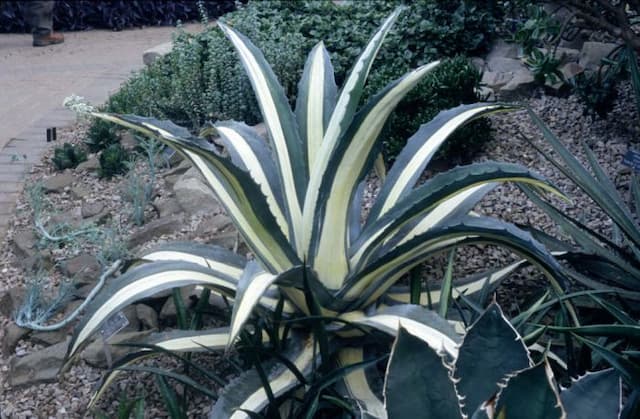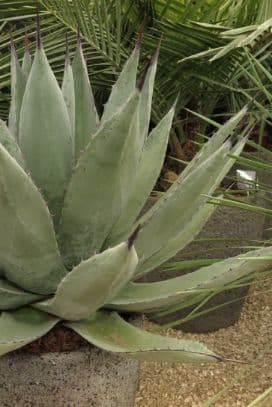Obscure Agave Agave obscura

ABOUT
The Agave obscura is a succulent plant characterized by rosettes of thick, fleshy leaves that are typically green in color. These leaves often have a powdery or waxy coating, which gives them a muted or dusty appearance. The edges of the leaves may be armed with spiny teeth, and a sharp point may be found at the tip of each leaf, which adds to its formidable look. The surface of the leaves can appear somewhat rigid and may carry patterns of lines or imprints that are reflective of the internal fibers. As a drought-tolerant plant, its leaves are adept at storing water, which contributes to their plump look. The Agave obscura's overall form is sculptural and it can add a striking aesthetic to the environments in which it is grown, showcasing a rough-hewn beauty that is typical of plants from arid regions.
About this plant
 Names
NamesFamily
Asparagaceae
Synonyms
Obscure Agave, Shadow Agave
Common names
Agave neglecta, Agave obscura subsp. obscura, Agave scolymus, Bonapartea obscura.
 Characteristics
CharacteristicsLife cycle
Perennials
Foliage type
Evergreen
Color of leaves
Green
Flower color
Yellow
Height
2-3 feet (0.6-0.9 meters)
Spread
2-3 feet (0.6-0.9 meters)
Plant type
Succulent
Hardiness zones
9
Native area
Mexico
Benefits
 General Benefits
General Benefits- Water Conservation: Agave obscura is drought-tolerant, requiring minimal water once established, making it ideal for xeriscaping and water-efficient landscaping.
- Sustainability: As a perennial plant that can live for several years, it reduces the need for annual planting and can help stabilize soil to prevent erosion.
- Habitat Support: Provides ecological support by offering food and shelter to wildlife, including pollinators like bees and butterflies.
- Ornamental Value: Its unique rosette shape and pointed leaves add aesthetic appeal to gardens, making it a popular choice for ornamental use.
- Edible Uses: Some parts of the plant, such as the agave nectar, are edible and can be used as a natural sweetener.
- Fiber Production: Agave plants, including Agave obscura, can be a source of fibers that are used in making ropes, textiles, and other traditional crafts.
 Medical Properties
Medical Properties- This plant is not used for medical purposes.
 Air-purifying Qualities
Air-purifying QualitiesThis plant is not specifically known for air purifying qualities.
 Other Uses
Other Uses- The fibers of Agave obscura can be extracted and used to make textiles or ropes due to their strength and durability.
- The sap of the agave plant can be fermented to produce a traditional Mexican alcoholic beverage known as pulque, distinct from tequila or mezcal.
- Agave obscura leaves can be used as natural fencing material due to their spiky edges, providing a barrier for garden areas or property lines.
- The leaves may also serve as compost material after they have dried out, contributing nutrients back into the soil.
- Agave syrup, made from the sap, is a sweetener that can be used as an alternative to sugar or honey in cooking and baking.
- When dried and hollowed out, the flowering stems can be used as didgeridoos or other musical instruments.
- The sharp tips of agave leaves have been traditionally used as needles or pins in various craft applications.
- Agave obscura can be incorporated into landscape design as an ornamental plant due to its unique appearance and low water requirements.
- The plant can be used as a biofuel source because the sugars in the sap can be fermented and distilled into ethanol.
- Agave roasting pits can be used for traditional cooking methods in certain cultures, where food is slow-cooked with the heat generated from the roasting agave hearts.
Interesting Facts
 Feng Shui
Feng ShuiThe Agave is not used in Feng Shui practice.
 Zodiac Sign Compitability
Zodiac Sign CompitabilityThe Agave is not used in astrology practice.
 Plant Symbolism
Plant Symbolism- Resilience: The Agave obscura is known for its ability to survive in harsh, arid environments. Its symbolism here reflects the ability to endure difficult conditions and adapt to challenges.
- Longevity: Agaves can live for many years, often growing for a long time before flowering. They symbolize long life and endurance over time.
- Self-reliance: Agave obscura is a plant that thrives with minimal care, representing independence and the ability to fend for oneself.
- Protection: With its strong, spiky leaves, the agave serves as a symbol of protection and defense against adversity.
- Healing and purification: Agave has been used in traditional medicine, symbolizing its qualities for healing and purifying.
 Water
WaterThe Agave obscura, commonly referred to as the Dwarf Butterfly Agave, requires occasional watering to maintain its health. It's adapted to arid environments and therefore does not need frequent watering. The watering schedule should follow a 'soak and dry' method, meaning the soil should be allowed to dry out completely between waterings. Typically, watering once every two to three weeks during the growing season is sufficient, and in the winter, this can be reduced even further. Provide about one gallon of water for each watering to ensure the root zone is thoroughly saturated.
 Light
LightAgave obscura, commonly known as Dwarf Butterfly Agave, thrives best in full sun to partial shade conditions. It prefers a spot where it can bask in the direct sunlight for at least six hours a day. However, it's also tolerant of partial shade, especially in extremely hot climates where it may benefit from some afternoon protection from the harshest sun rays.
 Temperature
TemperatureAgave obscura, or Dwarf Butterfly Agave, is a hardy plant that prefers temperatures ranging from 50 to 80 degrees Fahrenheit but can withstand temperatures as low as the mid-20s for short periods. The ideal temperature for growing an Agave obscura ranges between 70 to 80 degrees Fahrenheit. It's important to protect the plant from frost, which can damage the foliage.
 Pruning
PruningPruning the Dwarf Butterfly Agave involves removing dead or damaged leaves to maintain the plant's appearance and health. Pruning is best done in the spring or early summer when the plant is actively growing. Simply use a sharp, clean pair of clippers or scissors to cut away any unsightly leaves close to the base. However, Agave obscura does not require frequent pruning; once yearly or as needed should suffice.
 Cleaning
CleaningAs needed
 Soil
SoilAgave obscura, commonly known as Dwarf Century Plant, thrives best in a well-draining soil mix that can be composed of one part potting soil, one part coarse sand, and one part perlite or pumice. The soil should be slightly acidic to slightly alkaline, ideally ranging in pH from 6.0 to 7.5. It's important to ensure proper drainage to prevent root rot.
 Repotting
RepottingDwarf Century Plant should be repotted every 2 to 3 years or when it outgrows its container. Care should be taken not to damage the roots during repotting, and it's best to repot in the warmer months when the plant is actively growing.
 Humidity & Misting
Humidity & MistingDwarf Century Plant prefers low to moderate humidity levels, as it is tolerant of dry air conditions typically found in arid and semi-arid environments. It does not require high humidity and too much moisture in the air can lead to fungal problems.
 Suitable locations
Suitable locationsIndoor
Grow Dwarf Century Plant in a sunny spot, in well-draining soil.
Outdoor
Plant Dwarf Century Plant in full sun, with well-draining soil.
Hardiness zone
9-11 USDA
 Life cycle
Life cycleAgave obscura, also known as the Obscure Agave, begins its life as a seed, which germinates in well-drained soil with adequate warmth and light. It grows into a rosette of fleshy leaves, capable of storing water to survive in arid environments, and this rosette stage can last for several years. As it matures, it develops a deep root system and continues to enlarge, storing energy for its eventual flowering. The plant reaches maturity after several years, which varies per individual, and at this point, it produces a tall flower stalk that may reach several meters in height. This flowering stage, which happens only once in the plant's lifetime, results in numerous flowers that can attract pollinators such as bats and insects. After flowering and subsequent seed production, the agave plant typically dies, completing its life cycle, though it may have produced offsets or 'pups' around its base that continue its lineage.
 Propogation
PropogationPropogation time
Spring-Early Summer
Propogation: The Agave obscura, commonly known as Dwarf Butterfly Agave, is most effectively propagated by the removal of offsets, also known as "pups," which are produced around the base of the parent plant. The best time to propagate is late spring to early summer when the plant is actively growing, which promotes better root development in the new plants. To propagate using offsets, wait until the pups are a few inches wide, then carefully separate them from the mother plant using a sharp, clean knife or spade. It’s essential to let the cut areas dry and callous over for a few days to prevent rot when planted. Once calloused, the offsets can be planted in well-draining soil, preferably a mix of potting soil and sand or perlite. Water sparingly at first, only enough to moisten the soil without making it soggy, and gradually increase as the plants establish. This method is favored as it maintains the genetic integrity of the parent plant and usually ensures successful growth.









